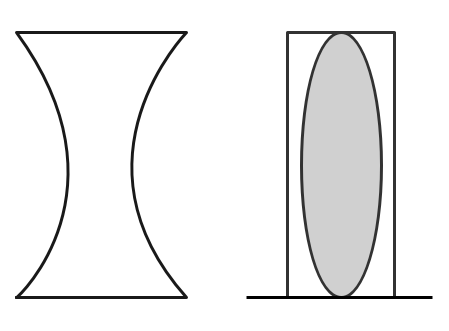Question
Question: An equi concave diverging lens of focal length \(F\) is cut into two equal halves. The two halves ar...
An equi concave diverging lens of focal length F is cut into two equal halves. The two halves are turned around and joined with some liquid between them. The lens obtained is converging with a focal length F. If the refractive index of the liquid is 3, then what is the refractive index of the lens?

Solution
We know that the lens makers formula for thin lenses, where F is the focal length, also R=2F, μ is the refractive index of the lens and R1 and R2 is the radius of curvature of the spheres of surfaces 1 and 2 respectively.
Formula used:
F1=(μ−1)(R11−R21)
Complete step by step answer:
We also know that the focal length F of the concave lens given by the lens makers formula is expressed as F1=(μ−1)(R2), where μ is the refractive index of the concave lens and R is its radius of curvature.
Now consider the focal length of the combination of two halves of the concave lens and the liquid with refractive index μl=3.
Then clearly f11=(μ−1)(∞1−R1)=(μ−1)(−R1)
Similarly, f31=(μ−1)(∞1−R1)=(μ−1)(−R1)
But since the f2 has some liquid between them, then we get, f21=(μl−1)(R1−R1)=(μl−1)(R2)
We can write it as f11+f21+f31=(μ−1)(−R1)+(μl−1)(R2)+(μ−1)(−R1)
An equiconvex lens of focal length F is cut into two equal halves and the joined with some liquid between them, we can say that F1=f11+f21+f31
Then we can get, (μ−1)(R2)=(μ−1)(−R1)+(μl−1)(R2)+(μ−1)(−R1)
⇒(μ−1)(R2)=(μ−1)(−R2)+(μl−1)(R2)
⇒(μ−1)(R2)=[(−1)(μ−1)+(μl−1)]×(R2)
⇒μ−1=−μ+μl
2μ=μl+1
Given μl=3
μ=24=2
Thus the refractive index of the lens 2
Hence the answer is B.2
Note:
The lens makers formula as the name suggests is used in the making of the lens. Also clearly, more the refractive index of the lens or combination of lens and liquid, less the focal length. Whereas, the more the radius of curvature of the spherical lens, the more is the focal length of the lens.
